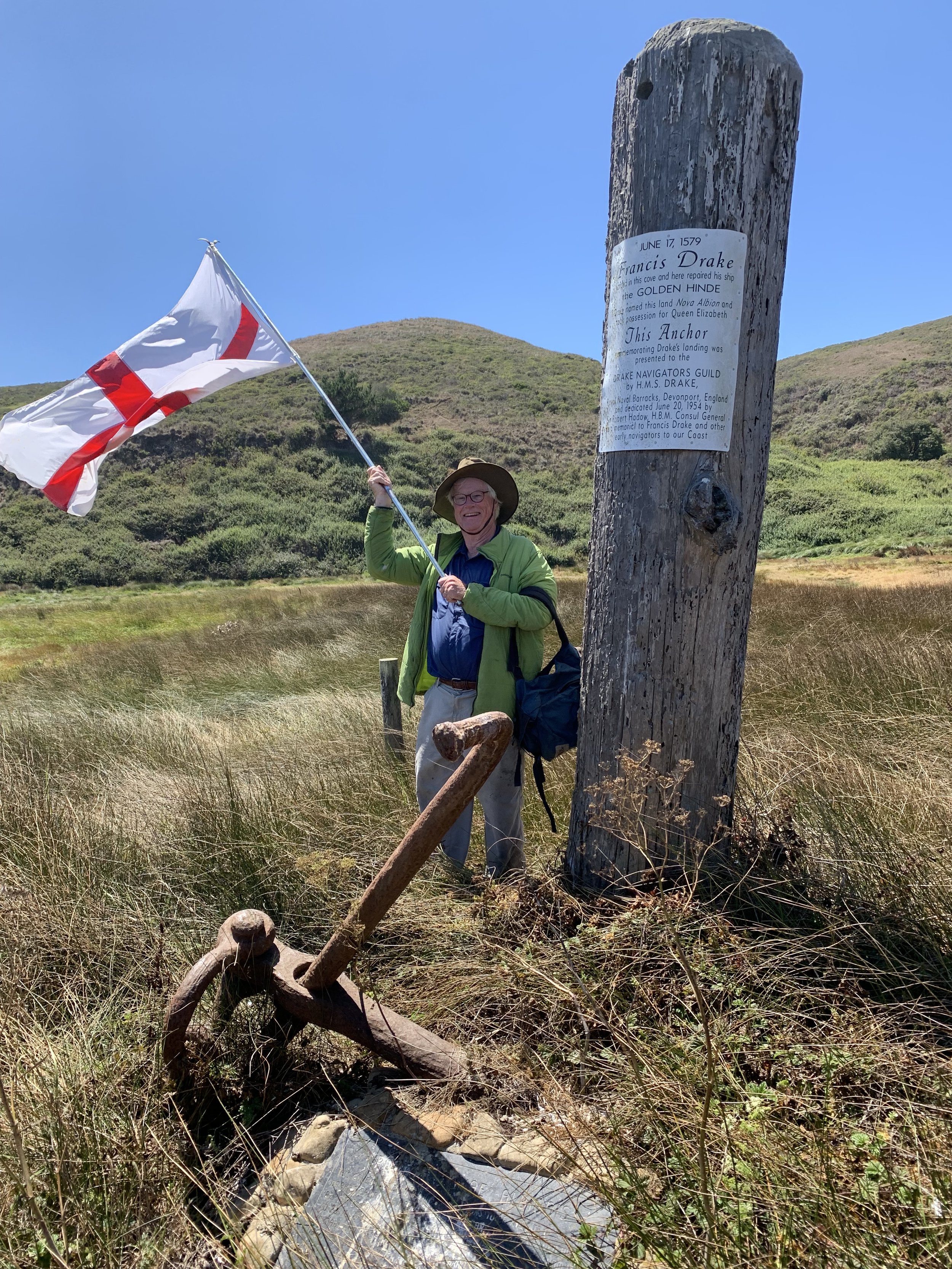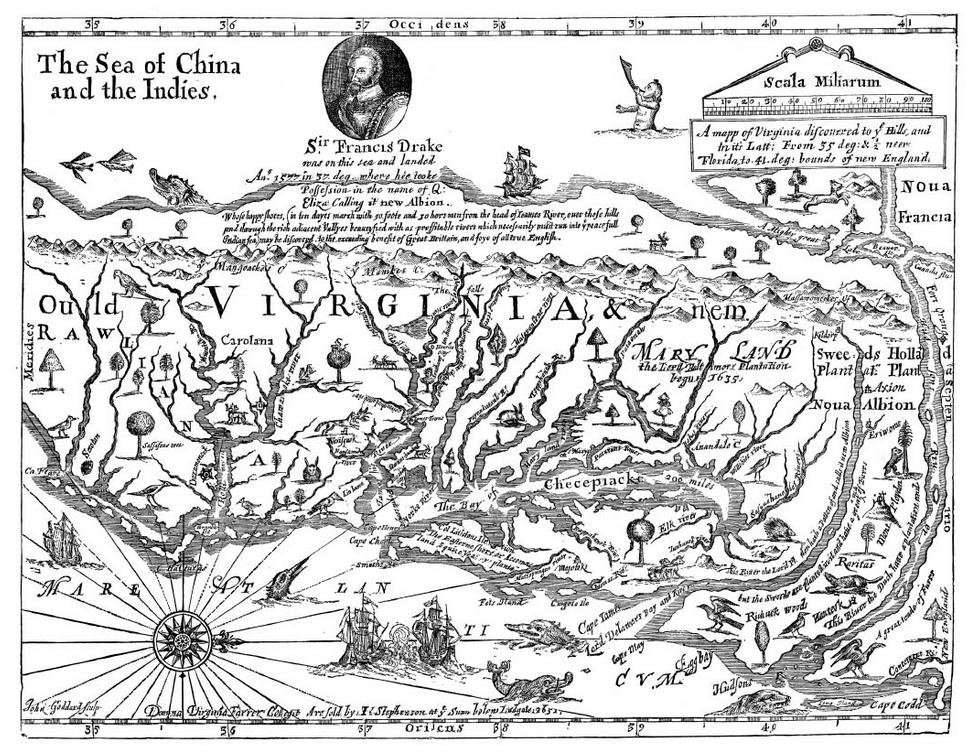New Albion Overview
DNG director, Phillip Williams, stands by a monument erected at Drake’s Cove on the 375th anniversary of Drake’s landing. The anchor is from HMS Drake Barracks and donated by honorary DNG member, Louis Mountbatten, 1st Earl Mountbatten of Burma.
Image Courtesy of Steve Wright
New Albion defies exactness. A precise description is difficult.
New Albion is many things: a territory, a discovery, a legal claim, a traditional homeland, a modern homeland, an inked name on maps, and a grand idea. It is part of a journey and bold adventure that made a man famous, a king furious, and a queen delighted. It is a place where strangers became friends and soon parted. It is the beginning of an upstart nation’s rise to power and the foreshadowing of the tragic decline of an entire people.
New Albion is an amazing story of how the human spirit interacts with the currents of history. And even with all of this, New Albion is still much more.
The physical location of New Albion’s site—the place where Sir Francis Drake and his crew landed, encamped, and anchored the Golden Hind—is on the California coast in traditional Coast Miwok homeland. The site is now part of the Point Reyes National Seashore.
When Drake sailed the Golden Hind, around a point along California’s Pacific shore in 1579, he and the crew were grateful to be sent into the bay that now bears his name. The sole inhabitants of the immediate area were the Coast Miwok people. Fully astounded and awestruck from where these strange, striking visitors came or who they were, the Coast Miwok held a magnificent ceremony and crowned Drake just as if he were king. This was, however, a misunderstanding of the English crew. The Coast Miwok culture regarded the Pacific Ocean western expanse from which these pale, smelly strangers appeared as a place of their deceased ancestors. Misunderstanding the Englishmen as honored ancestors was a striking moment for the people. What neither group understood, despite their cordial interactions, was that this contact was a precursor to the tragic, eventual demise and destruction of the California traditional homelands, culture, and people.
With his highly uncertain understanding of Coast Miwok consent, Drake named and claimed the land Nova Albion, New Albion, for his queen, Elizabeth I. He recorded the claim on a plate of brass and pronounced it to the world by nailing the plaque to a post. Of course, this claim came without full disclosure to the Coast Miwok; tragically—though it would be a centuries long process—this claim forecast the encroachment on their homeland, a delayed encroachment that would eventually yield devastating effects.
The original name Nova Albion, translated literally, means New White. Of course, Nova Albion may seem an odd moniker. But, to Drake it made much sense. Nova translates as New. And Albion, a Latin derivative meaning White, was a very early name cartographers assigned to England. So, to accurately understand the name, the best translation for Nova Albion is New England.
This name was a nod to the white cliffs on England’s eastern coast. The white cliffs at Point Reyes, which are strikingly similar to those in England, were the inspiration for Drake’s name for the land. The white cliffs were undoubtedly a welcome site for travel weary, homesick sailors.
Watch this video of Sky Road Webb singing a song in the Coast Miwok language. Drake landed in the traditional homeland of the Coast Miwok.
This 1651 John Ferrar map depicts New Albion, shown with Drake’s image, as only a few days trek from Virginia. He places New Albion at 37°. This map has an unusual orientation of west at the top.
Wikipedia Commons Imgage
These two videos provide outstanding overviews of the 1579 New Albion. On the left, this video is a detailed, 40 minute Power Point presentation by Dr. Philip Williams of the DNG. On the right, YouTuber Poopy Archaeology—an American archaeologist in non-YouTube life—provides an excellent and entertaining 10 minute video.
No exact boundaries were ever established for New Albion, so maps vary as to how far the claim extended. Some show it as a general west coast region while others extend it well east, across the North American continent. Others show it as part of the island of California. Detailed charting and surveys would not take place until many years into the future, so there was much mystery to this land.
It is also a place where Sebastián Rodríguez Cermeño made an ill-fated landing in 1595 when his ship dragged her anchors and sunk in a terrible storm. And it is where Cermeño and his surviving crew showed their astonishing mettle by constructing a small boat and audaciously sailing it to the safety of a Mexican port.
Today the area is not known as New Albion, rather it is mostly known to as Point Reyes. It is a coastal environment and home to several small communities, all within a close area dangerously bisected by the San Andreas fault. Point Reyes National Seashore covers much of the land where Drake and his crew camped. The National Historic Landmark, Drake’s Bay Historic and Archaeological District, and the California State Historical Landmark, Site of New Albion, are on Seashore property. These protect the area and commemorate the coming together of the Coast Miwok, the Cermeño expedition, and the Drake expedition. Today, this land is a serene place, and a scenic 30 mile drive north from the Golden Gate Bridge will take you into the heart of its beauty.
So, New Albion is many things, all part of the magnificent story of this historic place of great human significance.

